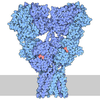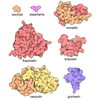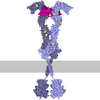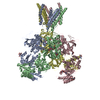+ Open data
Open data
- Basic information
Basic information
| Entry | Database: PDB / ID: 9arg | |||||||||
|---|---|---|---|---|---|---|---|---|---|---|
| Title | Rat GluN1-GluN2B NMDA receptor channel in apo conformation | |||||||||
 Components Components |
| |||||||||
 Keywords Keywords | MEMBRANE PROTEIN / Ligand-gated ion channel / ionotropic glutamate receptor / synaptic membrane protein | |||||||||
| Function / homology |  Function and homology information Function and homology informationcellular response to curcumin / cellular response to corticosterone stimulus / cellular response to magnesium starvation / sensory organ development / pons maturation / positive regulation of Schwann cell migration / regulation of cell communication / regulation of cAMP/PKA signal transduction / EPHB-mediated forward signaling / sensitization ...cellular response to curcumin / cellular response to corticosterone stimulus / cellular response to magnesium starvation / sensory organ development / pons maturation / positive regulation of Schwann cell migration / regulation of cell communication / regulation of cAMP/PKA signal transduction / EPHB-mediated forward signaling / sensitization / auditory behavior / Assembly and cell surface presentation of NMDA receptors / response to hydrogen sulfide / olfactory learning / conditioned taste aversion / dendritic branch / regulation of respiratory gaseous exchange / response to other organism / protein localization to postsynaptic membrane / regulation of ARF protein signal transduction / fear response / transmitter-gated monoatomic ion channel activity / apical dendrite / response to carbohydrate / positive regulation of inhibitory postsynaptic potential / response to methylmercury / response to glycine / propylene metabolic process / response to manganese ion / interleukin-1 receptor binding / cellular response to dsRNA / cellular response to lipid / response to glycoside / positive regulation of glutamate secretion / negative regulation of dendritic spine maintenance / response to growth hormone / regulation of monoatomic cation transmembrane transport / NMDA glutamate receptor activity / Synaptic adhesion-like molecules / RAF/MAP kinase cascade / voltage-gated monoatomic cation channel activity / neurotransmitter receptor complex / NMDA selective glutamate receptor complex / heterocyclic compound binding / ligand-gated sodium channel activity / glutamate binding / response to morphine / regulation of axonogenesis / calcium ion transmembrane import into cytosol / neuromuscular process / regulation of dendrite morphogenesis / regulation of synapse assembly / protein heterotetramerization / male mating behavior / glycine binding / response to amine / receptor clustering / parallel fiber to Purkinje cell synapse / small molecule binding / suckling behavior / regulation of long-term synaptic depression / positive regulation of reactive oxygen species biosynthetic process / startle response / monoatomic cation transmembrane transport / social behavior / behavioral response to pain / positive regulation of calcium ion transport into cytosol / response to magnesium ion / associative learning / regulation of postsynaptic membrane potential / regulation of MAPK cascade / action potential / cellular response to glycine / extracellularly glutamate-gated ion channel activity / monoatomic cation transport / excitatory synapse / positive regulation of dendritic spine maintenance / positive regulation of excitatory postsynaptic potential / response to electrical stimulus / regulation of neuronal synaptic plasticity / monoatomic ion channel complex / cellular response to manganese ion / long-term memory / Unblocking of NMDA receptors, glutamate binding and activation / glutamate receptor binding / behavioral fear response / response to mechanical stimulus / detection of mechanical stimulus involved in sensory perception of pain / synaptic cleft / multicellular organismal response to stress / neuron development / prepulse inhibition / phosphatase binding / postsynaptic density, intracellular component / monoatomic cation channel activity / calcium ion homeostasis / response to fungicide / glutamate-gated receptor activity / D2 dopamine receptor binding / regulation of neuron apoptotic process Similarity search - Function | |||||||||
| Biological species |  | |||||||||
| Method | ELECTRON MICROSCOPY / single particle reconstruction / cryo EM / Resolution: 4.05 Å | |||||||||
 Authors Authors | Chou, T.-H. / Furukawa, H. | |||||||||
| Funding support |  United States, 2items United States, 2items
| |||||||||
 Citation Citation |  Journal: Nature / Year: 2024 Journal: Nature / Year: 2024Title: Molecular mechanism of ligand gating and opening of NMDA receptor. Authors: Tsung-Han Chou / Max Epstein / Russell G Fritzemeier / Nicholas S Akins / Srinu Paladugu / Elijah Z Ullman / Dennis C Liotta / Stephen F Traynelis / Hiro Furukawa /  Abstract: Glutamate transmission and activation of ionotropic glutamate receptors are the fundamental means by which neurons control their excitability and neuroplasticity. The N-methyl-D-aspartate receptor ...Glutamate transmission and activation of ionotropic glutamate receptors are the fundamental means by which neurons control their excitability and neuroplasticity. The N-methyl-D-aspartate receptor (NMDAR) is unique among all ligand-gated channels, requiring two ligands-glutamate and glycine-for activation. These receptors function as heterotetrameric ion channels, with the channel opening dependent on the simultaneous binding of glycine and glutamate to the extracellular ligand-binding domains (LBDs) of the GluN1 and GluN2 subunits, respectively. The exact molecular mechanism for channel gating by the two ligands has been unclear, particularly without structures representing the open channel and apo states. Here we show that the channel gate opening requires tension in the linker connecting the LBD and transmembrane domain (TMD) and rotation of the extracellular domain relative to the TMD. Using electron cryomicroscopy, we captured the structure of the GluN1-GluN2B (GluN1-2B) NMDAR in its open state bound to a positive allosteric modulator. This process rotates and bends the pore-forming helices in GluN1 and GluN2B, altering the symmetry of the TMD channel from pseudofourfold to twofold. Structures of GluN1-2B NMDAR in apo and single-liganded states showed that binding of either glycine or glutamate alone leads to distinct GluN1-2B dimer arrangements but insufficient tension in the LBD-TMD linker for channel opening. This mechanistic framework identifies a key determinant for channel gating and a potential pharmacological strategy for modulating NMDAR activity. | |||||||||
| History |
|
- Structure visualization
Structure visualization
| Structure viewer | Molecule:  Molmil Molmil Jmol/JSmol Jmol/JSmol |
|---|
- Downloads & links
Downloads & links
- Download
Download
| PDBx/mmCIF format |  9arg.cif.gz 9arg.cif.gz | 515.2 KB | Display |  PDBx/mmCIF format PDBx/mmCIF format |
|---|---|---|---|---|
| PDB format |  pdb9arg.ent.gz pdb9arg.ent.gz | 393.1 KB | Display |  PDB format PDB format |
| PDBx/mmJSON format |  9arg.json.gz 9arg.json.gz | Tree view |  PDBx/mmJSON format PDBx/mmJSON format | |
| Others |  Other downloads Other downloads |
-Validation report
| Summary document |  9arg_validation.pdf.gz 9arg_validation.pdf.gz | 1.4 MB | Display |  wwPDB validaton report wwPDB validaton report |
|---|---|---|---|---|
| Full document |  9arg_full_validation.pdf.gz 9arg_full_validation.pdf.gz | 1.4 MB | Display | |
| Data in XML |  9arg_validation.xml.gz 9arg_validation.xml.gz | 85.1 KB | Display | |
| Data in CIF |  9arg_validation.cif.gz 9arg_validation.cif.gz | 127.9 KB | Display | |
| Arichive directory |  https://data.pdbj.org/pub/pdb/validation_reports/ar/9arg https://data.pdbj.org/pub/pdb/validation_reports/ar/9arg ftp://data.pdbj.org/pub/pdb/validation_reports/ar/9arg ftp://data.pdbj.org/pub/pdb/validation_reports/ar/9arg | HTTPS FTP |
-Related structure data
| Related structure data |  43781MC 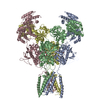 9areC 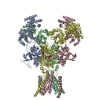 9arfC 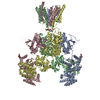 9arhC 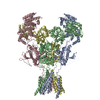 9ariC 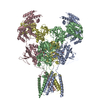 9bibC M: map data used to model this data C: citing same article ( |
|---|---|
| Similar structure data | Similarity search - Function & homology  F&H Search F&H Search |
- Links
Links
- Assembly
Assembly
| Deposited unit | 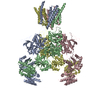
|
|---|---|
| 1 |
|
- Components
Components
| #1: Protein | Mass: 95225.883 Da / Num. of mol.: 2 Source method: isolated from a genetically manipulated source Source: (gene. exp.)   #2: Protein | Mass: 98888.945 Da / Num. of mol.: 2 Source method: isolated from a genetically manipulated source Source: (gene. exp.)   Has protein modification | Y | |
|---|
-Experimental details
-Experiment
| Experiment | Method: ELECTRON MICROSCOPY |
|---|---|
| EM experiment | Aggregation state: PARTICLE / 3D reconstruction method: single particle reconstruction |
- Sample preparation
Sample preparation
| Component | Name: Di-heterotetrameric GluN1-GluN2B NMDA receptors / Type: COMPLEX / Entity ID: all / Source: RECOMBINANT |
|---|---|
| Molecular weight | Value: 0.400 MDa / Experimental value: NO |
| Source (natural) | Organism:  |
| Source (recombinant) | Organism:  |
| Buffer solution | pH: 7.5 |
| Specimen | Conc.: 4 mg/ml / Embedding applied: NO / Shadowing applied: NO / Staining applied: NO / Vitrification applied: YES |
| Specimen support | Grid type: Quantifoil R1.2/1.3 |
| Vitrification | Instrument: FEI VITROBOT MARK IV / Cryogen name: ETHANE / Humidity: 85 % / Chamber temperature: 285 K |
- Electron microscopy imaging
Electron microscopy imaging
| Experimental equipment |  Model: Titan Krios / Image courtesy: FEI Company |
|---|---|
| Microscopy | Model: FEI TITAN KRIOS |
| Electron gun | Electron source:  FIELD EMISSION GUN / Accelerating voltage: 300 kV / Illumination mode: FLOOD BEAM FIELD EMISSION GUN / Accelerating voltage: 300 kV / Illumination mode: FLOOD BEAM |
| Electron lens | Mode: BRIGHT FIELD / Nominal defocus max: 2800 nm / Nominal defocus min: 1400 nm |
| Image recording | Electron dose: 66.3 e/Å2 / Film or detector model: GATAN K3 BIOQUANTUM (6k x 4k) |
- Processing
Processing
| EM software |
| |||||||||||||||||||||||||||||||||
|---|---|---|---|---|---|---|---|---|---|---|---|---|---|---|---|---|---|---|---|---|---|---|---|---|---|---|---|---|---|---|---|---|---|---|
| CTF correction | Type: NONE | |||||||||||||||||||||||||||||||||
| 3D reconstruction | Resolution: 4.05 Å / Resolution method: FSC 0.143 CUT-OFF / Num. of particles: 60195 / Symmetry type: POINT | |||||||||||||||||||||||||||||||||
| Atomic model building | Protocol: BACKBONE TRACE | |||||||||||||||||||||||||||||||||
| Atomic model building | PDB-ID: 7SAA Accession code: 7SAA / Source name: PDB / Type: experimental model | |||||||||||||||||||||||||||||||||
| Refine LS restraints |
|
 Movie
Movie Controller
Controller








 PDBj
PDBj